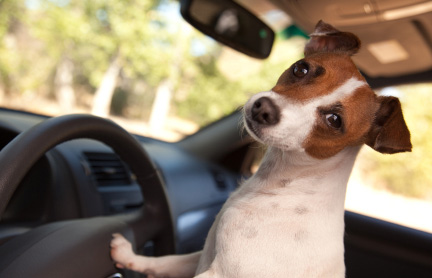Protect Your Pets from Heat!
Summertime can be fun for Fluffy and Fido, but only if you make sure to keep them safe!

Though most of us love summer, we have choices that enable us to seek out the sun and enjoy hot days when we want to, taking steps to avoid sunburn and overexposure to heat when we need to. But very often animals do not have the same choices, relying instead on the common sense and prudent actions of their owners to provide them with a safe, cool, comfortable environment.
According to the Massachusetts SPCA, on a seemingly pleasant 80-degree day, the inside of a car can heat up to 110 degrees in 10 minutes–even with the windows slightly open. As the moments pass, a vehicle’s interior becomes a virtual oven with temperatures quickly climbing to 120 or 130 degrees and higher, whereby an animal quickly experiences painful hyperthermia (dangerously elevated body temperature with symptoms that include heavy panting, drooling, unsteadiness, lethargy and vomiting), heatstroke, organ damage, and death.
In Maine, in August of 2011, a news story reported the circumstances of a pet owner who’d left her Golden Retriever in the car “for a few minutes” to shop in a big box store–in fact for pet products. Within minutes the dog began showing signs of distress from the heat, passersby reportedly observing this, but by one account, because the windows were “cracked open,” they did nothing. The dog subsequently died in the car of heatstroke, and unfortunately this occurrence is more common than most people think. According to the Humane Society of the United States (HSUS), because so many incidents go unreported, exact statistics are not available, but some authorities estimate national numbers run into the high hundreds each year.
Sit and Stay (Home)
As awareness is always the first step, experts advise that you refrain from taking animal companions on errands in summer months if they are to be left in a car, though they may love to ride and we certainly relish their company. While some earnest pet owners claim they take all necessary precautions in a parked car to provide accessible water to prevent dehydration, open windows wide (though this offers the risk that a pet may jump out or be stolen), and park under a shady tree, the sun shifts around quickly and what is initially perceived as shade can quickly become a heat trap. Sun beating through the windshield of a car creates a sauna for anyone inside, and if you typically kennel your dog in the back of the vehicle where there is no escape from the sun’s grueling effects on the rear windshield, the chances of heatstroke and death increase. In short, it’s best to leave your pet in a cool, ventilated or air conditioned home.
According to veterinarians, occasionally a dog is brought in suffering from the effects of heat though the owner claims to have left him in the car “with the air conditioning running.” In these situations, it’s important to bear in mind that unless the car is moving, the air conditioning system is not operating at full capacity and may in fact begin to run warm after a few minutes. Reasoning that leaving the animal in a vehicle under these conditions while enjoying an hour or two of shopping or a restaurant meal is simply not wise.
Going the Distance–Early
Because we love summer and are committed to getting outdoors more, some of us choose to stay in shape by hiking or running, desiring the same kind of exercise for our dogs. Remember for us it’s a choice, not so much for them. Because dogs are loyal and wish to please, above all, they will often run to keep pace and go the distance with their owners in high temperatures–to the point of heat exhaustion and death. Unlike a human companion, they do not call out or slow down–unless you do– when they are tired or overheated. Given their fur coats (imagine running in 85 or 90-degree temperatures in a wool sweater or coat), and the fact that dogs have no pores through which to sweat and release heat, they do so through panting and the pads of their feet–which may be pounding away on scorching asphalt or sand. Aside from resulting painful burns and blisters, their body temperature, higher than ours to begin with, can heat up much faster under this kind of exertion. If you must run with your pet in summer, experts say the best time to do so is around sunrise or immediately thereafter, when the night air and lack of sun have allowed for relative cooling (next best option would be evening, though the heat of day is still around at that time). Try and run on grass or an equally cool surface, always bring lots of water, and pause frequently to allow your canine companion to drink and release heat.
Overexposed
Though sunburn is not readily associated with pets, in fact they may be more predisposed to it than humans for the simple fact that their normal body state is to be covered up with fur. While some well-intentioned pet owners shave their pets in summer, believing it will help keep them cool, in fact it exposes sensitive, unconditioned skin to the sun, allowing for painful sunburn. If you wish to go this route, having their fur cut short is a better way to go. Additionally, if your dog has a pink nose and spends time outdoors, a lighter proboscis is more prone to sunburn than a darker one, just as more fair-skinned humans might be, and vets advise applying sunscreen (be sure to rub in well to avoid the pet licking it off). As the tips of the ears are also sensitive to the sun, especially in lighter-colored dogs, a dab or two there will help fend off the sun.
What can I do?
If you see an animal in a car on a hot day, and especially if the windows are unopened or even “cracked,” experts advise not to assume the owner is close by or will be out shortly. If in a grocery store, big box or restaurant parking lot, take down the license plate and immediately go to the manager to make an announcement. If this is not possible, or if no one responds, call the police or animal control.
Remember in rising summer temperatures, every minute counts. In some jurisdictions, police have the authority to break into the car if the animal is in distress and in others they must wait for animal control, but the important thing is not to waste any time. If you do not wish to be identified, calls to law enforcement can remain anonymous but be sure to provide the license plate number and exact location of the vehicle. It’s also a good idea to wait–even at a distance–to make sure authorities come as it may require multiple requests. Summer is a busy time in many regions of the country, especially tourist areas, so don’t assume your call will be instantly heeded.
With your own pet, try using drive-up banking windows, drive-thru pharmacies, and fast food restaurants. Some nicer restaurants and cafes have outdoor eating spaces that welcome canine companions. Because pets are nearly a 50 billion dollar-a-year industry, more and more clothing, gift, specialty and other stores now allow leashed pets inside, which is a nice option for you and your best friend to relax, cool down, and spend some time together.
Signs of heatstroke in pets:
-excessive panting
-body temperature exceeding 104 degrees
-dark or bright red tongue or gums
-tacky or dry tongue or gums (dehydration)
-diarrhea, vomiting
-seizures, stupor, staggering or coma
Necessary actions:
-seek veterinary attention immediately
-use cool water on pads of feet and abdomen en route to vet office; do not use ice water, which can constrict blood vessels and impede cooling
-allow pet to lick ice cubes if desired, but do not force water
Beth Herman
Beth Herman is a freelance writer with interests in healthy living and food, family, animal welfare, architecture and design, religion, and yoga. She writes for a variety of national and regional publications, institutions, and websites.






These are great tips. My cats love to play outside, but I always keep their cat door unlocked for them and keep fresh, cold water in their dispenser. No way I’d leave my kitties to bake. My husband and I are planning on getting a dog too, so this will be a good resource for when that happens as well. 🙂